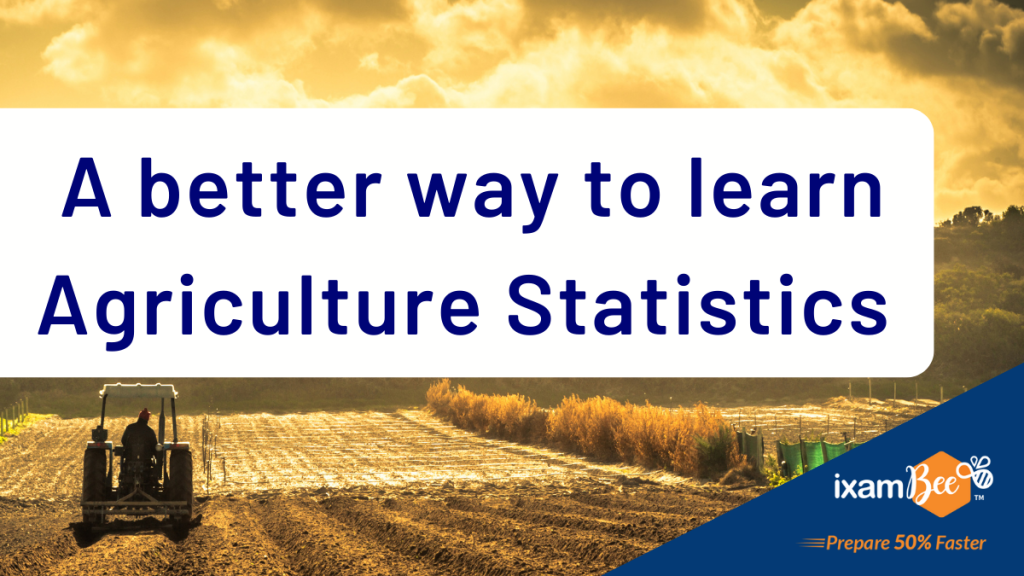Agriculture statistics is one of the most important parts of the exams like NABARD Grade A, IBPS AFO, and even RBI Grade B. It is also one of the complicated parts of the syllabus to learn. Here, we must know statistics right from food grain production, horticulture production to the particulars of different states. There is no end to the different types of statistics in agriculture. But, anyhow we have to learn those to get a good edge over other candidates in the exam. The unpredictable nature of questions in the exam makes it even more difficult to study agriculture statistics.

Importance of Agriculture Statistics:
· Agriculture statistics are directly asked in the Phase 1 of the exams. Hence, we cannot afford to ignore this topic.
· We can use agriculture statistics in the Phase 2 exam to enhance the quality of our descriptive answers. The use of statistics makes the answer even more convincing. Agriculture statistics are also asked directly through MCQs in phase 2.
· You can also use agriculture statistics while putting your opinion in front of the Interview panel.
Hence, agriculture statistics carry substantial importance in all 3 stages of the exam. Thus, it becomes important to learn them. But, there’s a limit to which we can memorize all the statistics. Tricks and shortcuts are useful to some extent, but if you understand the reasons behind them, you can retain the information for longer.
How to Learn Agriculture Statistics Conceptually?
So, in this article, we’ll learn about Food Grain Production & some individual crops and their production in states. We’ll also learn why some states are ranked higher in particular crop production than others. Our motive is to understand the concept behind it.
Let’s understand them one by one.
Wheat
- Uttar Pradesh (UP) is the highest wheat-producing state, followed by Madhya Pradesh (MP) & Punjab.
- UP & MP both have similar areas, but it’s the assured irrigation & other input facilities in the UP that makes it a top wheat producing state.
- Punjab on the other hand has a smaller area despite having a higher productivity, hence it is ranked third.
Thus, by keeping in mind the season & irrigation requirement of the crop, we can gauge its production areas.
Paddy
- West Bengal (WB) is the highest paddy producing state in the country. It is followed by UP & Punjab.
- UP, despite its larger area, is ranked second because WB is slightly ahead of it.
- In WB, paddy is produced in 2 to 3 seasons with more suitable land for rice cultivation. This helps WB to surpass the larger area advantage of UP & its paddy production.
- However, the difference between the two states’ production is very small.
Pulses
- Pulses require less irrigation for its production. This makes it a favourable crop in dry areas like Rajasthan, Madhya Pradesh.
- And rightly so, Madhya Pradesh is the highest pulses-producing state followed by Rajasthan & Maharashtra.
- UP & other northern states will not take pulses crops for production because of its low productivity, despite having required inputs.
Oilseeds
- Similar to Pulses, oilseeds are a rabi crop that requires moderate irrigation for growth.
- Rajasthan is a top oilseeds-producing state, followed by Gujarat & Madhya Pradesh.
Sugarcane
- Sugarcane needs a lot more irrigation for its production.
- Until recently, Maharashtra was a top sugarcane-producing state, but now UP has replaced it.
- The reason behind UP’s rise is the assured irrigation in the region with the fertile alluvial plains.
- Top 3 sugarcane producing states in the country are Uttar Pradesh, Maharashtra & Karnataka.
Food Grain Production
- Food grain production consists of paddy, wheat & all pulses.
- We’ve seen above that UP, MP & Punjab are neck to neck in terms of production of these crops.
- UP is ranked first & second wheat & paddy respectively. This makes it a top food grain-producing state. The larger area also adds more to its production.
- Similarly, MP due to its size is ranked behind UP in the food grain production.
- Punjab is ranked third due to its higher productivity.
Green Revolution
- The above agriculture statistics show the impact of the Green Revolution in the northern states like UP & Punjab.
- The Green Revolution gave impetus to the production of wheat & paddy in the country. Thus, the crops like Pulses were not produced on scale, due to their lower productivity.
This was all about Part-1 of the Agriculture Statistics. We’ll bring you another part on the remaining topics, to help you prepare agriculture statistics in a holistic way.
For more such conceptual learning, visit the following link:
https://www.ixambee.com/cpss-concept
To help you prepare 50% faster for competitive exams, ixamBee provides free Mock Test Series all the Current Affairs in English and Current Affairs in Hindi in the BeePedia capsules for GA Preparation. You can also get the latest updates for Bank PO, Bank Clerk, SSC, RBI NABARD and Other Government Jobs.
Also Read
iEX- ixamBee Exam Experience (Your Complete Exam Experience)














